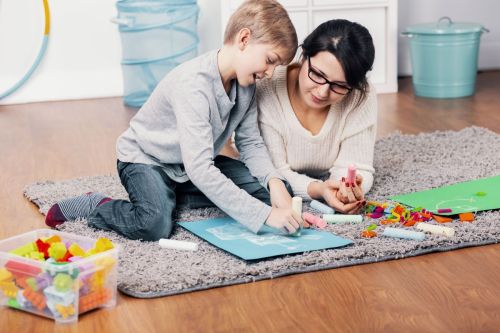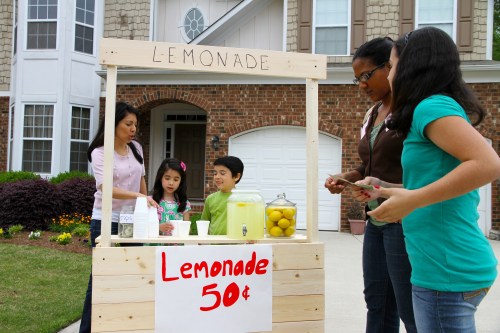As a parent, you likely spend at least some amount of time (maybe even a lot) wondering about your child’s future. You want them to be happy, sure, but you also want them to be independent, hardworking, and capable of achieving their dreams.
Whether your kids are in their early tweens or on the cusp of independence, it’s never too late to teach them about setting and accomplishing goals. If you’re unsure of where to start, this guide will give you a ton of goal ideas, help teach kids the best goal-setting strategies, and help you uncover how to help your kid follow through on their plans—whatever they may be.
Key takeaways
- Setting goals isn’t just about achievements, it’s about forming healthy habits around time management, perseverance, and resilience when setbacks happen.
- Kids can use the SMART criteria to set goals: specific, measurable, attainable, realistic, and timebound.
- Help kids set goals by listening to their opinions, keeping goals realistic, and teaching the difference between short- and long-term goals.
- Failure happens, but it’s an opportunity to learn. Use the SMART criteria to evaluate what happened and keep it positive!
Why is goal-setting important for kids?
During childhood, kids form the lifestyle habits and patterns that follow them into adulthood. Learning how to set goals and follow through with them may or may not come naturally for your kid. However, practicing these skills at a young age can help make goal-setting easier for them in the future. Whether their future goals involve finishing university, owning a house, or starting their own business, they’ll be more capable of turning these goals into a reality if they start small in childhood.

What are the benefits of setting goals?
Setting and accomplishing goals are more than just positive reinforcements—although, it always feels great to reach a milestone! Setting and accomplishing goals also help kids learn valuable skills:
- Responsibility: Whether or not they reach their goal is no one’s job but their own. Taking ownership will help them reach success.
- Time management: If their goal has a deadline, they’ll have to learn how to manage their time to meet it. This is a skill that will serve them in their career.
- Resilience: Setbacks are a part of life, especially for a goal that’s challenging. If kids want to reach the goal badly enough, they’ll learn to cope with failure.
- Perseverance: To reach their goal, they may have to try, change tack, and try again.
What are SMART kids’ goals?
SMART is an acronym that stands for specific, measurable, attainable, realistic, and timebound. It’s one way your kid can check if the goal they want to set is “smart,” meaning it makes sense for them and is something they can actually achieve. To check if a goal meets the SMART criteria, run it through this checklist:
- Specific: Is the goal broken down into clear steps?
- Measurable: How will your child know when they’ve reached their goal? Getting “better” at something isn’t a clear way to measure success. Changing that C+ to an A-, however, is.
- Attainable: Does your child have the skills and resources necessary to reach the goal?
- Realistic: Does the goal actually matter to your child? How will achieving the goal give them satisfaction and/or improve their life?
- Timebound: What is the deadline (or deadlines, if there are multiple steps) for reaching the goal?
What are some examples of goals for kids?
Goal-setting for kids and teens is similar to goal-setting for adults; although, there may be fewer steps, shorter timelines, and the targets will be different. Here are four good goal ideas for kids to practice:
Academic goals
Your child can set homework goals, reading goals, or grade goals for assignments or classes. For example: “I want to get an A in my language arts class, so I’ll complete my homework each night before I get any screen time.”
Financial goals
Typically, financial goals for kids and teens would revolve around saving money for something special or managing a first credit card. For example: “I want to buy a video game and I need $20 more. I will do $5 worth of extra chores each week, so that I can buy the game in four weeks.”

Social goals
Your child might want to overcome their fear of public speaking or make more friends at school. For example: “I want to make two new friends this year, so I will attend at least half of the birthday parties I’m invited to, even though I’m shy.”
Habit goals
Your child may want to have a cleaner room, get more exercise, or reduce their disposable plastic use because they care about climate change. For example: “I want to declutter my room, so I’ll spend an hour going through my closet and drawers every Sunday until I have three boxes to donate.”
Read more: How can students give back to the community.
5 ways to help your kids and teens set goals
A big part of goal-setting for kids and teens is choosing the right goal (or goals, but there shouldn’t be too many at once, as it can be overwhelming—even for adults). Aside from running through the SMART goals checklist, you and your kid can also take a few additional steps to ensure a goal makes sense for them. Below are some of the best goal-setting strategies for kids of any age:
1. Let kids choose
You may have a whole list of goals that you wish your child would set—but restrain yourself. Even if you desperately want your kid to keep their room tidy, get straight As, or score the most goals on their hockey team, they’ll probably be more likely to reach the goal if it’s something that matters to them.
2. Keep an ear out for more options
Your child may voice a wish without thinking too much about it, like, “I wish I could get the lead in the school play” or, “I wish I had a backpack like that kid in my class.” Take those opportunities to talk about the wish, see if it’s realistic and meaningful (that is, it will still matter in a week), then brainstorm concrete steps to turn that wish into a goal.
3. Make goals realistic
Small, easy-to-achieve goals are a good place to start, because they can create momentum. Once your kid has had some success, they’ll be more inclined to level up their next goal to something a bit more out of reach, but still within the realm of possibility. For example, if your child usually earns $5 per week for chores, it’s not realistic for them to set their sights on buying a $100 toy within a month, even if they double or triple the number of chores they do.
4. Set short-term and long-term goals
The two main types of goals, short-term and long-term, can work in tandem:
Short-term goals
For kids, these goals should take less than a month. They can also become steps that are part of a long-term goal. Some short-term goal examples include reading one chapter of a book each night for a week or holding a garage sale to make money for a new video game.
Long-term goals
As the name suggests, these goals take longer to achieve than short-term goals. Some examples of long-term goals include getting an A in a class at the end of the school year or being accepted into their university of choice.
5. Stick with age-appropriate goals
Even though some kids are naturally more goal-oriented and motivated than others, they’re still kids. Adult goals and goals for kids or teens shouldn’t look the same, because kids may have different capabilities, shorter attention spans, more difficulty with delayed gratification, and fewer ways to earn money. Keep in mind your child’s age limits when they start goal-setting. Achieving smaller victories is much better than never reaching something impossible.
Read more: How to help kids and teens avoid impulse buying.
4 ways to help your kids achieve goals
You can help your child set and achieve their goals by sitting down with them to create a plan and encouraging them to stick with it.
1. Write down goals
Start by encouraging your kids to write down their goal. Don’t worry about checking all the SMART boxes just yet. Focus on the R (realistic) to find short- or long-term goals that matter to your child. Studies show that the simple act of writing goals on paper makes accomplishing them more likely.
2. List steps to reach goals
If a goal is too vague or too big, it can feel overwhelming, so it’s best to break it down into more detailed steps—sometimes called “goal posts.” Once your child has a list of relevant goals, give them the SMART treatment. Help your child make the goal “specific” and “attainable” by breaking it down into bite-sized chunks. It should be easy to know when a step has been completed (meaning, the step is “measurable”), and there should be a deadline for completion (which makes the goal “timebound”).
3. Monitor progress
Though you can’t force your child to work toward their goals, you can check in with them to offer support and see if they’re making progress. Suggest they create a chart on a poster board or write deadlines in a calendar, so they can visualize the journey. Then, you’ll both have a clear way to see if your child’s on track.
Sometimes checking on progress means changing the plan. For example, some steps may take longer than your child originally thought, and that’s all part of the process.
4. Provide positive affirmations
Working toward goals takes time and dedication. Let your kids know you see their effort and are proud of it. Your opinion matters greatly to your child—even if they don’t always say so.

What happens if kids fail to reach a goal?
Failure doesn’t always feel good, but it can also be a great teacher. Instead of narrowing the goal to match your child’s abilities, see what can be learned from the failure. After all, failure is often a necessary stepping stone to success. (Stephen King once had a wall of rejection letters and has now sold more than 400 million books worldwide!)
Next, you can re-evaluate the goal together:
- Praise your child’s efforts. The end result isn’t the only thing that matters.
- Review the goal. Was it too vague? Was it unrealistic? The SMART steps can help here, too.
- Ask your child for suggestions. Do they have ideas for what they could do differently moving forward?
- Brainstorm the benefits of achieving the goal next time. How will they feel?
- Avoid threats or bribes throughout the process.
The bottom line
Setting goals and working toward them teaches kids valuable skills, ranging from perseverance to time management, that will benefit them as they go through life. While accomplishing goals is ultimately your child’s responsibility, you can still help them set targets that are specific, measurable, attainable, realistic, and timebound (SMART). Plus, you can support them by checking in on progress and offering positive feedback.
In the end, your child will learn the ropes of goal-setting by learning to work for the things they want—whether that’s an A in science or financial freedom as an adult. And with its tasks feature and weekly paydays managed by parents, Mydoh can help tweens and teens learn to save up for financial goals.
Download Mydoh and help build the foundation of financial literacy for your kids and teenagers.
This article offers general information only and is not intended as legal, financial or other professional advice. A professional advisor should be consulted regarding your specific situation. While the information presented is believed to be factual and current, its accuracy is not guaranteed and it should not be regarded as a complete analysis of the subjects discussed. All expressions of opinion reflect the judgment of the author(s) as of the date of publication and are subject to change. No endorsement of any third parties or their advice, opinions, information, products or services is expressly given or implied by Royal Bank of Canada or its affiliates.

Teach Your Kids How To Earn, Spend & Save Money
with the Mydoh App &
Add up to five kids and two parents on one account.












